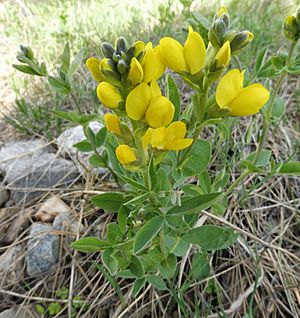Prairie thermopsis facts for kids
Quick facts for kids Thermopsis rhombifolia |
|
|---|---|
 |
|
| Scientific classification | |
| Genus: |
Thermopsis
|
| Species: |
rhombifolia
|
Thermopsis rhombifolia, also known as the prairie thermopsis, is a pretty yellow flowering plant. It belongs to the legume family, which includes plants like peas and beans. This plant grows naturally in North America.
Contents
About the Prairie Thermopsis
The prairie thermopsis is a type of plant that comes back year after year. This means it is a perennial. Each spring, it grows new stems and leaves, then blooms with bright yellow flowers.
Where It Grows
You can find the prairie thermopsis in many parts of North America. It is common in the Great Plains, which are large areas of flat grassland. It also grows in the lower parts of the Rocky Mountains. This plant likes to live in dry grasslands and open woodlands.
What It Looks Like
This plant is easy to spot when it's blooming. It has tall stems with many bright yellow flowers. The flowers look a bit like pea flowers, which makes sense since it's in the legume family. Its leaves are usually divided into three parts, like a clover.
Uses and Safety
For a long time, native people used the prairie thermopsis. They found ways to use parts of the plant.
Traditional Uses
The bright yellow flowers were often used to make a yellow dye. This dye could color fabrics or other materials. People also boiled parts of the plant to make a tea. This tea was sometimes used to help with stomach problems for both people and horses.
Important Safety Warning
It is very important to know that the prairie thermopsis has toxic properties. This means it can be harmful if someone eats it. If ingested, it can cause problems like vomiting, feeling dizzy, and pain in the stomach area. Because of this, you should never eat any part of this plant. It is best to just enjoy its beauty from a distance!

